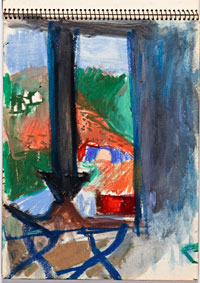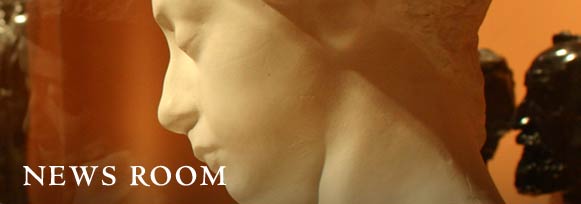Richard Diebenkorn’s Career
Viewed Through His Sketchbooks: Exhibition, Website and Book
Plus Talk by His Daughter
Richard Diebenkorn: The Sketchbooks Revealed on view Exhibition extended through August 22, 2016
• All the sketchbooks are now online
• Available Nov. 4, publication with essays & illustrations
• Nov. 4, at 5:30 pm, free lecture by Diebenkorn’s daughter
• View video about the sketchbooks
Stanford, Calif. — The Cantor Arts Center at Stanford University announces the launch of a new website that gives worldwide access to the museum’s unparalleled collection of 29 sketchbooks by Richard Diebenkorn (1922–1993), a renowned artist celebrated as both a central figure in the Bay Area figurative movement and a key figure in the nationwide development of abstract expressionism and color-field painting. The sketchbooks, a recent gift to the Cantor from the artist’s widow and long-time muse, Phyllis Diebenkorn, as well as from the Diebenkorn Foundation, are presented in Richard Diebenkorn: The Sketchbooks Revealed, a major exhibition that continues through August 22. The books contain 1,045 drawings dating from 1943 to 1993, all of which are now available for viewing online at a newly launched website. A video about the sketchbooks is on YouTube.
Throughout his long career, Diebenkorn (Stanford B.A., ’49) kept a sketchbook—a “portable studio,” as he called it—to capture his ideas. These books, now in the Cantor’s collection, span 50 years and represent the range of styles and subjects he explored, including deeply personal portraits of his wife, studies of the figure, landscape studies and compositions that point to Diebenkorn’s signature blend of figuration and abstraction. Richard Diebenkorn: The Sketchbooks Revealed explores the relationship between his sketchbooks and his paintings and includes loans of early works that Diebenkorn created as a Stanford student.
Touch screens installed in the exhibition, developed by Earprint Productions, allow visitors to leaf through all 29 books digitally and see every drawing. That same digital catalogue is now accessible for study online at diebenkornsketchbooks.stanford.edu. With this remarkable resource, audiences near and far can examine all of the sketches in the order in which Diebenkorn laid them down on paper. When viewed in full, the sketchbooks provide new insights into how Diebenkorn experimented with line, shape, form and perspective as he creatively tackled challenging subjects.
“Presented together and in their entirety online, the sketchbooks become a revelation of sorts, offering intimate access to the practice of a well-known, important and prolific artist,” said Connie Wolf, John and Jill Freidenrich Director of the Cantor Arts Center. “Now they are accessible for study by students, scholars and the general public at any time. This extraordinary collection, on view both in the museum and through the launch of this website, combined with the show’s associated publication and a lecture by the artist’s daughter, offers an unprecedented opportunity to understand the artist’s process.”
Lecture by Diebenkorn’s Daughter
Gretchen Diebenkorn Grant, daughter of Richard Diebenkorn, will share her insights and thoughts on the life and art of her father on Wednesday, November 4, at 5:30 pm in Cubberley Auditorium (485 Lasuen Mall, off the Main Quad in the School of Education and next to the clock tower). View map. Admission is free.
Diebenkorn Publication
A special publication accompanying the exhibition features selections from 28 of the sketchbooks, and Sketchbook 24 is reproduced in full. The volume includes more than 500 images in all, as well as four essays by Stanford-affiliated contributors plus a remembrance by the artist’s daughter Gretchen Diebenkorn Grant. The essays are:
- “Two Sides of a Coin: Reflections on Artistic Practice” by Enrique Chagoya (Professor of Art Practice, Stanford University)
- “Understanding Diebenkorn” by art historian Steven A. Nash (Stanford Ph.D., Art History, ’73)
- “The Ace of Spades” by Alexander Nemerov (Carl and Marilynn Thoma Provostial Professor in the Arts and Humanities and new chair of the Department of Art & Art History, Stanford University)
- “(With)Drawing from Mastery” by Peggy Phelan (Ann O’Day Maples Professor in the Arts, Professor of Drama and of English, Department of English, Department of Theater & Performance Studies, Stanford University)
The publication is available for $45 in the Cantor’s main lobby.
Diebenkorn Sketchbook Collection
Thanks to a gift from his late widow, Phyllis G. Diebenkorn, ’42, and a related donation from the Diebenkorn Foundation, the Cantor acquired in 2014 all of the artist’s sketchbooks, a matchless resource for understanding his approach to making art. Phyllis Diebenkorn, with the support of daughter Gretchen Diebenkorn Grant, ’67, MFA ’69, and son-in-law Richard Grant, the executive director of the Diebenkorn Foundation, said she was thrilled to entrust the Cantor with this important collection. The sketchbooks, which have never before been shown publically or thoroughly studied, provide unique and invaluable insight into the artist’s creative and intellectual processes. With this gift, the Cantor is positioned as an essential resource for international scholarship on Diebenkorn. This gift will be the basis for scholarly projects and programming aimed at investigating the sketchbooks’ relation to the historic tradition of the artist’s sketchbook. View a video about the sketchbooks with comments by Alison Gass, Associate Director for Exhibitions, Collections, and Curatorial Affairs.
Cantor Arts Center
The Cantor Arts Center at Stanford University is a vital and dynamic institution with a venerable history. Founded in 1891 with the university, the historic museum was expanded and renamed in 1999 for lead donors Iris and B. Gerald Cantor. The Cantor’s encyclopedic collection spans 5,000 years, includes more than 45,000 artworks and beckons visitors to travel across the globe and through time: from Africa to the Americas to Asia, from classical antiquity to the present day. With 24 galleries presenting selections from the collection and more than 20 special exhibitions each year, the Cantor serves Stanford’s academic community, draws art lovers from the San Francisco Bay Area and beyond and attracts campus visitors from around the world. Free admission, free tours, lectures, family activities and temporary exhibitions make the Cantor one of the most well-attended university art museums in the country and a great resource for teaching and research on campus.
# # #
Visitor Information
The Cantor Arts Center is open six days a week, Wednesday–Monday, 11 a.m.–5 p.m., Thursday until 8 p.m.; closed Tuesday. Admission is free. The Cantor is located on the Stanford campus, off Palm Drive at Museum Way. Parking is free after 4 p.m. weekdays and all day on weekends and major holidays. Information: 650-723-4177, museum.stanford.edu.
Notes to Editors
• To arrange an interview or obtain more information, contact Anna Koster, Head of Communications, Cantor Arts Center, 650-725-4657, akoster@stanford.edu
• For publicity images, contact PR Assistant Manager Margaret Whitehorn, Cantor Arts Center, 650-724-3600, mmwhite@stanford.edu
Learn more about programs, publication, and video. Review sketchbooks online.

Richard Diebenkorn (U.S.A., 1922–1993), Untitled from Sketchbook #10, page 15, 1943-1993. Gouache and crayon on paper. Cantor Arts Center collection, Gift of Phyllis Diebenkorn, 2014.10.17. © The Richard Diebenkorn Foundation

Richard Diebenkorn (U.S.A., 1922–1993), Untitled from Sketchbook #22, page 23, 1943–1993. Charcoal or conte crayon on paper. Cantor Arts Center collection, Gift of Phyllis Diebenkorn, 2014.22.25. © The Richard Diebenkorn Foundation.

Richard Diebenkorn (U.S.A., 1922–1993), Untitled from Sketchbook #16, page 13, 1943–1993. Pen and ink on paper. Cantor Arts Center collection, Gift of Phyllis Diebenkorn, 2014.16.15. © The Richard Diebenkorn Foundation.



